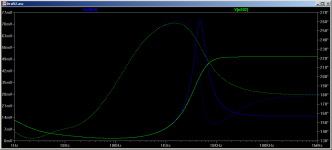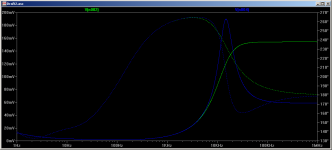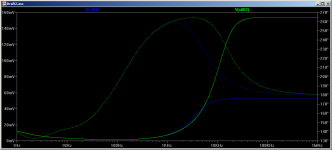Which caps do you use after regs?
I ask as I've read Rubycon ZA/ZL's are ideal after regs but I've also read that low esr caps are not good after regs. ZA's are low esr so which is correct? ZA's = good/bad?
Ta.
I ask as I've read Rubycon ZA/ZL's are ideal after regs but I've also read that low esr caps are not good after regs. ZA's are low esr so which is correct? ZA's = good/bad?
Ta.
It depends on what the regulator is, what the loading is, and what your preference is. A universal answer does not exist.
Low ESR caps are not good on the power lines, regardless of the location (before or after regs). Inductance of the power strips coupled with capacitance under variable load creates oscillations that need to be damped. Usually, the "normal" ESR values are enough to do that damping, but if you go on the low ESR route, there will be some ringing or worse.
Low ESR caps are to be used only series with the signal or where are employed means to damp the oscillations. Or oscillations don't matter - switched PS.
Low ESR caps are to be used only series with the signal or where are employed means to damp the oscillations. Or oscillations don't matter - switched PS.
Low ESR caps are not good on the power lines, regardless of the location (before or after regs). Inductance of the power strips coupled with capacitance under variable load creates oscillations that need to be damped. Usually, the "normal" ESR values are enough to do that damping, but if you go on the low ESR route, there will be some ringing or worse.
Low ESR caps are to be used only series with the signal or where are employed means to damp the oscillations. Or oscillations don't matter - switched PS.
That's what many have told me, I did a little research after posting and it seems the majority of literature also claims/proves the same.
Shame really, I trusted the judgement of a fellow member on this forum who also owns/runs a upgrade website/shop facilty and even states on his site that ZA's are ideal after regs.
Nevermind, you live and learn I suppose.
With apologies to SoNic_real_one as I know we are at odds over decoupling issues.
Perhaps the answer is to actually fit some of each type and do some real measurements rather than just taking everything on trust.
At least the low e.s.r. types offer the intriguing possibility (based on the above) of the performance improving as the caps age and e.s.r. increases... does this explain the fad of burning in exotic parts... the "newness" soon wears off.
Perhaps the answer is to actually fit some of each type and do some real measurements rather than just taking everything on trust.
At least the low e.s.r. types offer the intriguing possibility (based on the above) of the performance improving as the caps age and e.s.r. increases... does this explain the fad of burning in exotic parts... the "newness" soon wears off.
Perhaps the answer is to actually fit some of each type and do some real measurements rather than just taking everything on trust.
If you can't trust a so called 'audio engineer', who can you trust? I thought a diy audio forum that consists of thousands of members might be a good place to start, guess not.
There are 2 kinds of audio "afficiando".
- The ones that trust the measurements, the electrical and acoustical theories, try to understand them, their limitations and work with them to achieve better designs.
- The ones that don't understand the science behind all this, they prefer to disregard all the measurements and scientific theories and rely on word of the mouth in choosing their equipment/designs. They are actually a special kind of "belivers" in religion-like "audiophile" legends, in a certain "magic" that cannot be quantifyed in formulas.
One just have to choose a side...
- The ones that trust the measurements, the electrical and acoustical theories, try to understand them, their limitations and work with them to achieve better designs.
- The ones that don't understand the science behind all this, they prefer to disregard all the measurements and scientific theories and rely on word of the mouth in choosing their equipment/designs. They are actually a special kind of "belivers" in religion-like "audiophile" legends, in a certain "magic" that cannot be quantifyed in formulas.
One just have to choose a side...
There are 2 kinds of audio "afficiando".
- The ones that trust the measurements, the electrical and acoustical theories, try to understand them, their limitations and work with them to achieve better designs.
- The ones that don't understand the science behind all this, they prefer to disregard all the measurements and scientific theories and rely on word of the mouth in choosing their equipment/designs. They are actually a special kind of "belivers" in religion-like "audiophile" legends, in a certain "magic" that cannot be quantifyed in formulas.
One just have to choose a side...
Yes I understand (kind of), after I was told Rubycon ZA's would release detail I thought that was what I was looking for, it turns out that I couldn't be further away if I tried. The ZA's are detailed but theoretically and actually they sound bob (technical term), where's the music gone? all I can hear is detail.
Oh well, folk do push what they sell.
Ne'mind,
Hi nad, caps don't have a 'sound quality' as such, so ignore those who try to sell you an idea (or actual part) based upon the notion of components having such a quality.
What caps have are electrical characteristics which you have to manipulate to get what you want out of the circuit. I think there are three approaches to this... 1) learn all about impedance, reactance, and power supply decoupling, then buy some test kit and measure things accurately, or 2) read up on the subject from knowledgeable people and then try a few experiments (...low esr cap + 1 Ohm in series, low esr cap + 2 Ohms in series, etc., etc.) or 3) just 'hit and hope'. However number 3 is a receipe for frustration!
It probably comes down to maintaining the output impedance of the regulator over an extended band-width, while ensuring good transient response. There were a couple of good documents on the web about the subject but unfortunately I did not note the references. 🙁
Buying a few low ohm resistors to experiment in series with your low esr caps might be an idea. Good luck.
What caps have are electrical characteristics which you have to manipulate to get what you want out of the circuit. I think there are three approaches to this... 1) learn all about impedance, reactance, and power supply decoupling, then buy some test kit and measure things accurately, or 2) read up on the subject from knowledgeable people and then try a few experiments (...low esr cap + 1 Ohm in series, low esr cap + 2 Ohms in series, etc., etc.) or 3) just 'hit and hope'. However number 3 is a receipe for frustration!
It probably comes down to maintaining the output impedance of the regulator over an extended band-width, while ensuring good transient response. There were a couple of good documents on the web about the subject but unfortunately I did not note the references. 🙁
Buying a few low ohm resistors to experiment in series with your low esr caps might be an idea. Good luck.
There are 2 kinds of audio "afficiando".
- The ones that trust the measurements, the electrical and acoustical theories, try to understand them, their limitations and work with them to achieve better designs.
- The ones that don't understand the science behind all this, they prefer to disregard all the measurements and scientific theories and rely on word of the mouth in choosing their equipment/designs. They are actually a special kind of "belivers" in religion-like "audiophile" legends, in a certain "magic" that cannot be quantifyed in formulas.
That is a very narrow and biased viewpoint. There are many other types of audio afficiandos than just two. How about an engineer who understands the therory, can and does make measurements - but ALSO listens, listens and listens. And never lets the theoretical and measured data affect the results of his listening tests, but works to optimise the sonic results from applying all the factors in the mix.
That's my type of audiophile designer/developer, and I know a few of them.
Unfortunately I also know even more of your types 1 & 2...
Regards, Allen
So you say that you know just a few guys that analyze the alternative designs, then measure the results with some equipments, and then listen with their ears and you think there are many others that don't listen???
I am sorry, I don't know any decent electronics engineer, that is involved in audio equipment design, that doesnt listen his (or others) creations. And doesn't test them with other in a (preferably blind) test. Because that is what SCIENCE requires.
On the other hand, I know plenty of "audiophilles" that never saw an electronics laborator room, but they dismiss all the measurements. For me that's just their reaction to the fact that they have a limited understanding of electrical and audio phenomenes.
And what you cannot understand needs to be ridiculed - in this way the self-esteem is still high. They invent a new, paralel pseudoscience, that they can understand to conter the real facts that they can't.
Just reat the thread about Schuman resonance here... There is no middle ground.
I am sorry, I don't know any decent electronics engineer, that is involved in audio equipment design, that doesnt listen his (or others) creations. And doesn't test them with other in a (preferably blind) test. Because that is what SCIENCE requires.
On the other hand, I know plenty of "audiophilles" that never saw an electronics laborator room, but they dismiss all the measurements. For me that's just their reaction to the fact that they have a limited understanding of electrical and audio phenomenes.
And what you cannot understand needs to be ridiculed - in this way the self-esteem is still high. They invent a new, paralel pseudoscience, that they can understand to conter the real facts that they can't.
Just reat the thread about Schuman resonance here... There is no middle ground.
Last edited:
I am sorry, I don't know any decent electronics engineer, that is involved in audio equipment design, that doesnt listen his (or others) creations.
I think you will find that many, especially in the larger corporations, don't undertake realistic evaluations. For them, if they've met the specification according to their test sets then it's 'job done'. Yes, really.
On the other hand, I know plenty of "audiophilles" that never saw an electronics laborator room, but they dismiss all the measurements. For me that's just their reaction to the fact that they have a limited understanding of electrical and audio phenomenes.
And what you cannot understand needs to be ridiculed - in this way the self-esteem is still high. They invent a new, paralel pseudoscience, that they can understand to conter the real facts that they can't.
I think you are right, these people do exist. (They thrive on the mystical element of it, as it reflects their psychology and / or boosts their ego. Sometimes they are pushing commercial products and use it to try and boost sales to others who think the same).
There is no middle ground.
Of course there is middle ground!
1 ohm is way too much. ESR values are in 1/100...1/10 ohms...
My reference was:
National Semiconductor datasheet
LM317L
Dated May 2006
Page 12; 80V Supply shows 10 Ohms in series with 1 micro F
Pages 12 and 13; High Voltage Regulators show 2.7 Ohms in series with 1 micro F
It is possible that I have misinterpreted the datasheet.
Here is a sim of what the output impedance of an LM317 circuit can look like with a 1000uf Low ESR cap on the output. I looked up the esr of a panasonic FM 1000uf 35V cap which is 0.015 Ohms... plugged that into the esr for the cap in spice and ran the sim (blue trace). In a duplicate circuit I changed the esr to 0.055 (ie added 0.04 ohms) the result is the green trace... go lower than an additional 0.04 ohms and the peaking starts again.
This is with a simulated load of around 50ma (10V out with 200R resistor) though the current source used for the test is 1A.
The peaking is less bad the higher the load current.
using a lower value cap requires more series resistance to dampen the peak.
the second plot is with a 100uF cap blue curve is with the standard esr of a 100uf 50V panasonic FM of 0.061 ohms. green trace is with esr of 0.17ohms which was the minimum required to damp the resonance.
The third plot shows the difference between the 1000uf blue trace, and the 100uF cap green trace, with appropriate series resistance added.
Note I haven't actually built this yet it is just a sim, but I thought it was relevant 🙂
Tony.
This is with a simulated load of around 50ma (10V out with 200R resistor) though the current source used for the test is 1A.
The peaking is less bad the higher the load current.
using a lower value cap requires more series resistance to dampen the peak.
the second plot is with a 100uF cap blue curve is with the standard esr of a 100uf 50V panasonic FM of 0.061 ohms. green trace is with esr of 0.17ohms which was the minimum required to damp the resonance.
The third plot shows the difference between the 1000uf blue trace, and the 100uF cap green trace, with appropriate series resistance added.
Note I haven't actually built this yet it is just a sim, but I thought it was relevant 🙂
Tony.
Attachments
Last edited:
My reference was:
National Semiconductor datasheet
LM317L
Dated May 2006
Page 12; 80V Supply shows 10 Ohms in series with 1 micro F
Pages 12 and 13; High Voltage Regulators show 2.7 Ohms in series with 1 micro F
It is possible that I have misinterpreted the datasheet.
No, that's quit right, and all the clues why this value varies are in the datasheet. My summary:
Using 3-pin regulators off-piste: part 3
- Status
- Not open for further replies.
- Home
- Source & Line
- Digital Source
- Which caps after regs?


